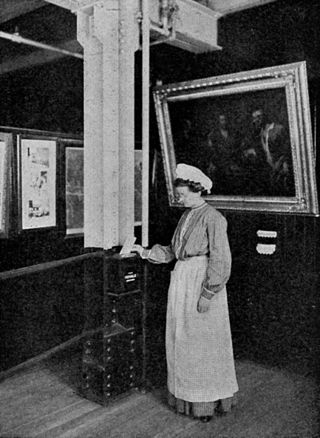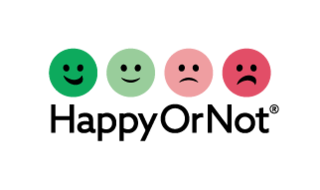Customer relationship management (CRM) is a process in which a business or other organization administers its interactions with customers, typically using data analysis to study large amounts of information.

Remote work is the practice of working from one's home or another space rather than from an office.

The point of sale (POS) or point of purchase (POP) is the time and place at which a retail transaction is completed. At the point of sale, the merchant calculates the amount owed by the customer, indicates that amount, may prepare an invoice for the customer, and indicates the options for the customer to make payment. It is also the point at which a customer makes a payment to the merchant in exchange for goods or after provision of a service. After receiving payment, the merchant may issue a receipt for the transaction, which is usually printed but can also be dispensed with or sent electronically.

Usability can be described as the capacity of a system to provide a condition for its users to perform the tasks safely, effectively, and efficiently while enjoying the experience. In software engineering, usability is the degree to which a software can be used by specified consumers to achieve quantified objectives with effectiveness, efficiency, and satisfaction in a quantified context of use.

Customer service is the assistance and advice provided by a company to those people who buy or use its products or services. Each industry requires different levels of customer service, but towards the end, the idea of a well-performed service is that of increasing revenues. The perception of success of the customer service interactions is dependent on employees "who can adjust themselves to the personality of the customer". Customer service is often practiced in a way that reflects the strategies and values of a firm. Good quality customer service is usually measured through customer retention. Customer service for some firms is part of the firm’s intangible assets and can differentiate it from others in the industry. One good customer service experience can change the entire perception a customer holds towards the organization.
The loyalty business model is a business model used in strategic management in which company resources are employed so as to increase the loyalty of customers and other stakeholders in the expectation that corporate objectives will be met or surpassed. A typical example of this type of model is: quality of product or service leads to customer satisfaction, which leads to customer loyalty, which leads to profitability.
Mystery shopping is a method used by marketing research companies and organizations that wish to measure quality of sales and service, job performance, regulatory compliance, or to gather specific information about a market or competitors, including products and services.
Customer satisfaction is a term frequently used in marketing to evaluate customer experience. It is a measure of how products and services supplied by a company meet or surpass customer expectation. Customer satisfaction is defined as "the number of customers, or percentage of total customers, whose reported experience with a firm, its products, or its services (ratings) exceeds specified satisfaction goals." Enhancing customer satisfaction and fostering customer loyalty are pivotal for businesses, given the significant importance of improving the balance between customer attitudes before and after the consumption process.

The suggestion box is used for collecting slips of paper with input from customers and patrons of a particular organization. Suggestion boxes may also exist internally, within an organization, such as means for garnering employee opinion.
Enterprise feedback management (EFM) is a system of processes and software that enables organizations to centrally manage deployment of surveys while dispersing authoring and analysis throughout an organization. EFM systems typically provide different roles and permission levels for different types of users, such as novice survey authors, professional survey authors, survey reporters and translators. EFM can help an organization establish a dialogue with employees, partners, and customers regarding key issues and concerns and potentially make customer-specific real time interventions. EFM consists of data collection, analysis and reporting.

Employee engagement is a fundamental concept in the effort to understand and describe, both qualitatively and quantitatively, the nature of the relationship between an organization and its employees. An "engaged employee" is defined as one who is fully absorbed by and enthusiastic about their work and so takes positive action to further the organization's reputation and interests. An engaged employee has a positive attitude towards the organization and its values. In contrast, a disengaged employee may range from someone doing the bare minimum at work, up to an employee who is actively damaging the company's work output and reputation.
Bizrate Insights Inc., doing business as Bizrate Insights, is a market research company, providing consumer ratings information to over 6,000 retailers and publishers across the United States, United Kingdom, France, Germany, and Canada. Bizrate Insights is a Dotdash Meredith company based in Los Angeles, CA.
Automated telephone surveys is a systematic collection a data from demography by making calls automatically to the preset list of respondents at the aim of collecting information and gain feedback via the telephone and the internet. Automated surveys are used for customer research purposes by call centres for customer relationship management and performance management purposes. They are also used for political polling, market research and job satisfaction surveying.
An exit interview is a survey conducted with an individual who is separating from an organization or relationship. Most commonly, this occurs between an employee and an organization, a student and an educational institution, or a member and an association. An organization can use the information gained from an exit interview to assess what should be improved, changed, or remain intact. More so, an organization can use the results from exit interviews to reduce employee, student, or member turnover and increase productivity and engagement, thus reducing the high costs associated with turnover. Some examples of the value of conducting exit interviews include shortening the recruiting and hiring process, reducing absenteeism, improving innovation, sustaining performance, and reducing possible litigation if issues mentioned in the exit interview are addressed.
Customer feedback management (CFM) online services are web applications that allow businesses to manage user suggestions and complaints in a structured fashion. A 2011 study conducted by Aberdeen Group showed that companies using customer feedback management services and social media monitoring have a 15% better customer retention rate.
With the application of probability sampling in the 1930s, surveys became a standard tool for empirical research in social sciences, marketing, and official statistics. The methods involved in survey data collection are any of a number of ways in which data can be collected for a statistical survey. These are methods that are used to collect information from a sample of individuals in a systematic way. First there was the change from traditional paper-and-pencil interviewing (PAPI) to computer-assisted interviewing (CAI). Now, face-to-face surveys (CAPI), telephone surveys (CATI), and mail surveys are increasingly replaced by web surveys.

Medallia is an American customer and employee experience management company based in San Francisco, California, with offices in Buenos Aires, London, Tel Aviv, Munich, Paris, New York City, Washington DC, Austin and Sydney.
Allegiance, Inc is a voice of customer (VoC) and enterprise feedback management (EFM) technology platform that let organizations collect and analyze consumer data in real time. The company was recognized for providing large companies and government agencies with a range of big data mining tools, and it was listed as one of the GSA’s approved vendors. Allegiance’s clients include VMware, Citi, AeroMexico, Nalco, Ameriprise, Adobe and Dell, and it was ranked as one of Inc. magazine’s fastest-growing companies.

HappyOrNot Ltd. is a Finnish instant feedback company that makes terminals for measuring customer satisfaction. The company has invented Smiley Terminals and by September 2020 it had sold them in 135 countries. The terminals consist of four smiley-faced buttons that customers are invited to press to indicate whether they are very happy, happy, unhappy or very unhappy with the service they were provided. This information is used by companies to find points where they are providing suboptimal service and to improve it.
Customer data or consumer data refers to all personal, behavioural, and demographic data that is collected by marketing companies and departments from their customer base. To some extent, data collection from customers intrudes into customer privacy, the exact limits to the type and amount of data collected need to be regulated. The data collected is processed in customer analytics. The data collection is thus aimed at insights into customer behaviour and, eventually, profit maximization by consolidation and expansion of the customer base.








